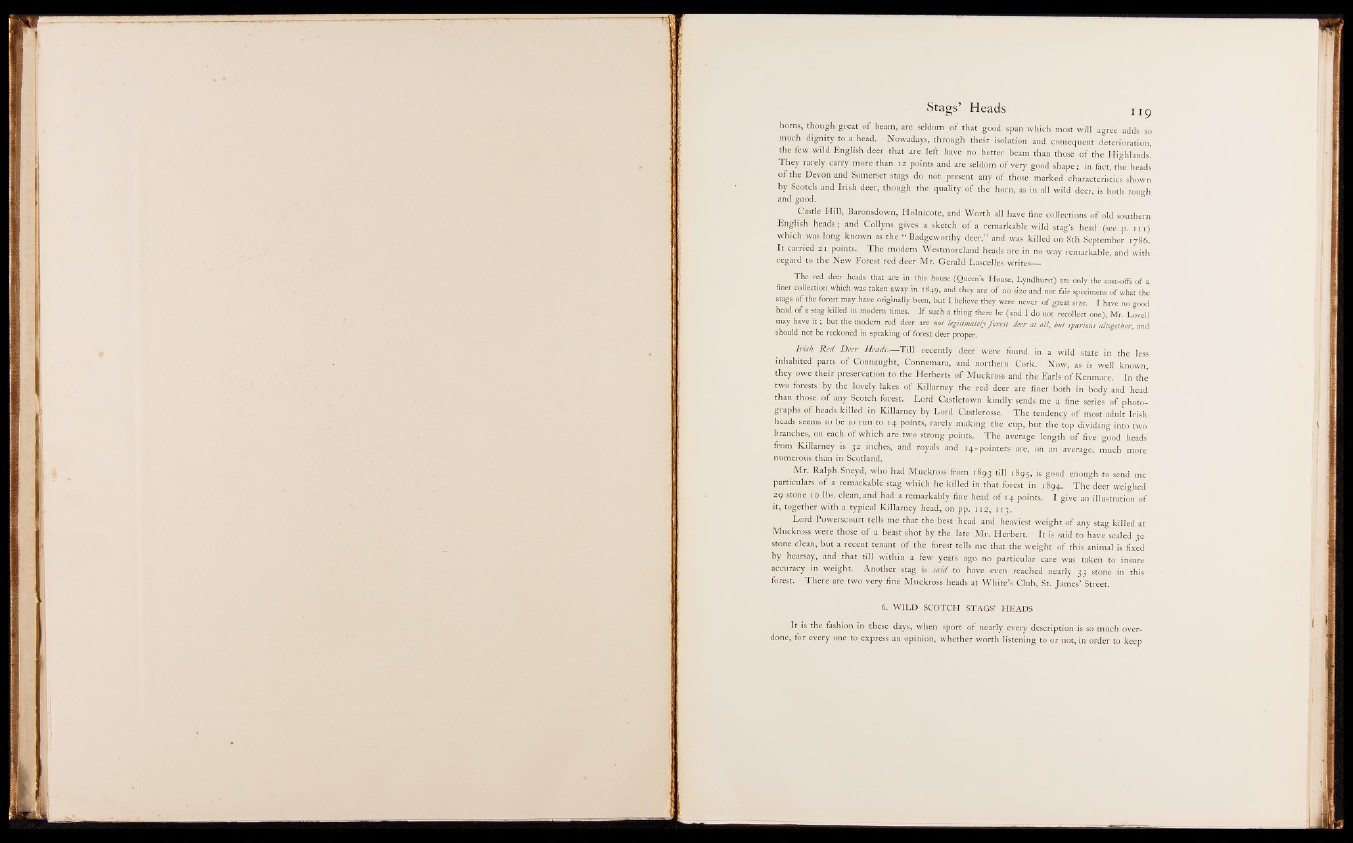
Stags Heads tip
horns, though greatsef beam, are s ltqm o f that- good span which most will agree adds'iso
m u c h p p i t y to a head. Nowadays, through their, isolation and consequent deterioration,
the few wild English deer that are left hay*: no better beam than those o f the Highlands!
I l l g P rarely carry iM%e than 12 points and are seldj.in of very good shape ; in feet, the heads
o f the Devon and Somerset stags do pot present any o f th j| | marked characteristics shown
by Scotch and Irish dbtt, though the qualigg'o# the horn, as in all wild deer,g both rough
and good.
<>tle Hill, Baronsdown, Holnicote, an * Worth all nawhem
English heads; and CoUyr.s gives a sketch a f :a remarkable wildgja'g’s head (see p. m )
which was long k n fÿ n â||h e « Badgeworthy deer," and was' killed on 8th September .f/8'6.
It carried 21 p o in ts| |T h e modern Westmoreland heads are lnWiHray remarkable, and with
regard,'to, the N ew Forest red ijfer Mr. Gerald Lâscelles writes__
The red deer heads that are in this house ( Ouecr. s House, Lyndhurst) are only the cast-offs wtfz-
finer collection which was taken away in 1849, and they are of no size and. not fair specimens of what the
stags of the forest may have originally been, but I believe they were never of great size. I have no good
head of a stag killed in modern times. I f such a thing there be (and Ido not recollect one), Mr. Lovell
may have it- ; but the modem red deer are not legitimately forest deer at all, lut spurious shag,the,-, and
should not be reckoned in speaking of forest deer proper.
Irish Red Deer recently deer were fiftfeg in a w i lM t a f l in the lesijinhabitip(;
parts o f eonnaughtMomnemara, and northern Cork. N e w , '« Ë | well known,
they owe their preservation to the Herberts H Muckross ami the Earls o f Kenmare. In the
two forests by the lovely lakes o f Killarney the red deer are finer both in b|tty and head
than t h g g o f any Scotch forest Lord Castletown kindly sends me a fine M M ph J E
graphs o f heads killed, in Killarney by Lo-d Castlcrosse. The tendency o f most adult Irish
heads, seems t oW f e run to H g in t s , rarely making the cup, but the top dividing into two
branchespvon each^df which are two strong(j>oints. The average: length o f five fapd heads
from Killarney is 32 inches, and roylM; and 14-pointers are; on ^.ave rage, much jqljffc
numerous than in Scotland.
Mr. Ralph Sf.cyd, who had Muckross from .893 till 1895.,as good enough to send me
particulars o f a remarkable stag which he killed in that forest in 1894. The deer weighed
29 stene m|lbs. clean, and had a remarkably fine head o f 14 points,: I give an illustration';®!
it, together with a typical Killarney head, on pp. 112, 113.
Lord Powerscourt tells me that the best head and heaviest weight o f any stag killed at
Muckross were those o f a beast shot by the late Mr. Herbert. It is said to have scaled 30
stone clean, but a recent tenant o f the forest tells me that the weight o f this animal is fixed
by hearsay, and that till within a few years ago no particular care was taken to insure
accuracy in weight. Another stag is said to have even reached nearly 33 stone in this
forest. There are two very fine Muckross heads at White’s Club, St. James’ Street.
6. WILD SCOTCH STAGS’ HEADS
It is the fashipn in these days, when sport o f nearly every description is so much overdone,
for every one to express an opinion, whether worth listening to or not, in order to keep